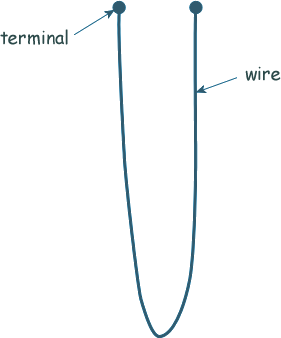Resistivity Question
Q6. A wire probe is used to measure the rate of corrosion in a pipe carrying a corrosive liquid.
The probe is made from the same metal as the pipe so the rate of corrosion of the wire in the probe is the same as in the pipe.
The diagram below shows the probe.

(a) The wire in an unused probe has a resistance of 0.070 Ω and a length of 0.50 m.
Given that the resistivity of metal in the wire is 9.7 × 10–8 Ω m, calculate the diameter of the wire.
R = ρ L/A
A = ρ L/R
A = 9.7 × 10–8 x 0.50/0.070
A = 6.93 x 10-7 
A = πr2 = π(d/2)2 = πd2/4
πd2/4 = 6.93 x 10-7 
d2 = 4 x 6.93 x 10-7/π
d2 = 8.82 x 10-7
d = 9.4 x 10-4 m 
[3 marks]
(b) In order to measure the resistance of a used working probe, it is connected in the circuit shown below.

When R3 is adjusted to a particular value the current in the cell is 0.66 A.
(i) Calculate the total resistance of the circuit.
You may assume that the cell has a negligible internal resistance.
V = IR
1.5 = 0.66 x R
R = 1.5/0.66
R = 2.27 Ω 
[1 mark]
(ii) The resistance of R2 is 22 Ω and the resistance of R3 is 1.2 Ω.
Calculate the current in R3.
V = 1.5 volts
I = ?
R(2&3) = 22 + 1.2 = 23.2 Ω
I = V/R(2&3)
I = 1.5/23.2
I = 0.0647 A 
[1 mark]
(iii) Calculate the resistance of the probe when the resistance of R1 is 2.4 Ω.
Current in the probe will be 0.66 - 0.0647 = 0.5953 A
V = IR
1.5 = 0.5953 x R(1 &P)
R(1 &P) = 1.5/0.5953 = 2.52 Ω 
RP = 2.52 - 2.4 = 0.12 Ω 
[3 marks]
(iv) Calculate the percentage change in the diameter of the probe when its resistance increases by 1.6 %.
R = ρ L/A
A ∝1/R
So cross sectional area will decrease by 1.6% 
But A ∝ d2
so, d ∝ √A = A½
and the diameter will decrease by 0.8% 
[2 marks]
(v) A voltmeter is connected between points A and B in the circuit and R3 stays at 1.2 Ω.
Explain, without calculation, why the reading on the voltmeter does not change when the cell in the circuit is replaced with another cell of the same emf but a significant internal resistance.
The voltmeter is comparing voltage distribution across the two strands. It takes negligible current as it has a very high resistance.
When the cell is changed the circuit voltage will decrease as part of the EMF is across the internal resistance of the cell. Therefore there will be 'lost volts' and a reduction in currnt flow. 
However the ratio of distribution of voltage across the strands will not alter as the ratio of resistances is still the same. 
[2 marks]
(Total 12 marks)








